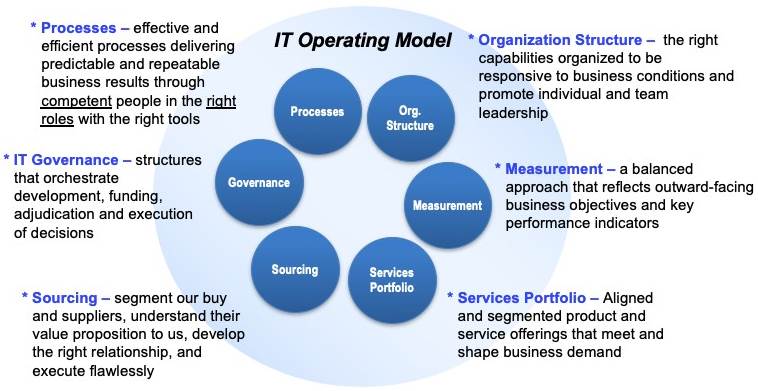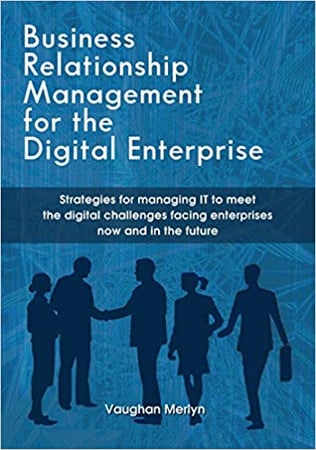“Do you need an IT operating model?”
This question that appeared in a LinkedIn group I sometimes visit led to an interesting discussion. One of the more noteworthy aspects was that several participants viewed an IT operating model as optional - something that IT organizations may choose to have or not have.
All IT organizations have an IT operating model. It might not be well communicated or well understood across IT. It might be implicit rather than explicit. It might be badly broken. But every IT organization has an operating model or they would not be able to operate. The significant questions to ask about an IT operating model are:
- Is it formalized? (i.e., was it designed with deliberation, not just an accident of bygone reorganizations?)
- Is it effective? (i.e., does it consistently deliver what the business needs in the most effective ways?)
- Is it efficient? (i.e., does it make the best possible use of assets and resources?)
- Is it clear to all those who depend upon it? (i.e., do stakeholders understand it?)
- Is it healthy? (i.e., is it continuously improving and sustainable?)
Beyond the Org Chart
In many organizations the only explicit manifestation of their operating model is an organizational chart. This is an incredibly limited (and limiting) way of expressing how an IT organization operates in any meaningful way.
The org chart illustrates who reports to whom, but it doesn’t explain what gets done or how it gets done. It tells you nothing about decision rights, key metrics or services. It says nothing about needed competencies or rules of engagement between functions and groups.
The keys are organizational clarity and health. An effective IT operating model should:
- Reduce confusion and noise about the management of IT across a company, division, or enterprise,
- Consistently deliver what is demanded by the business-IT strategy,
- Be able to flex amid changes in demand or supply patterns.
The IT Operating Model Is About More than IT
As business and IT functions inevitably converge with advances in technology and the appetite for all things digital, the IT operating model should address all aspects of IT across the enterprise. Increasingly, many elements of the model will be outside of the IT organization, so there is an important aspect of business access to and ownership of the IT operating model.
Components of an IT Operating Model
An IT operating model (illustrated below) is the basic framework that an IT organization follows to get its products and services into the hands of its partners.

The primary elements of an IT operating model are:
- Processes: How to perform activities that deliver predictable and repeatable business results through competent people using the right tools. For example,
- How is demand shaped?
- How is demand surfaced and clarified?
- How is demand turned into solutions that deliver the intended (or better) business results?
- Governance: How to make and sustain important decisions about IT. For example,
- How do business needs and initiatives get prioritized?
- How does IT manage the tensions between local and global optimization?
- How are standards chosen, and what are the consequences for deviations?
- Sourcing: How are the sources for IT products and services to selected and managed? For example,
- How can the scale of IT be leveraged?
- What work is done offshore, near shore, onshore, in house, in source, by contract?
- Services: How is the portfolio of IT products and services defined? For example,
- What is in the service catalog?
- How are services and service levels defined and managed?
- How are services differentiated by customer segment?
- Measurement: How is performance measured and monitored? For example,
- What are the shared goals of the IT organization?
- How to determine the value realized and delivered through IT investments?
- How is IT improving over time?
- Organization: How is the IT organization structured and organized? For example,
-
- What capabilities should be located within the IT organization and what can be within business units?
- How does IT organize around major projects and programs?
- How does IT organize around major products and platforms?
Note that I have deliberately put Organization last in the list. For years, when I’ve been consulting on IT operating model design, clients invariably want to start with the org chart. I call that ‘rearranging the deckchairs.’ It rarely solves anything. On the other hand, if you work through the other elements – services, processes, governance, etc., the organizational decisions fall out relatively easily and far more coherently.
Exploring an IT Operating Model for the Digital Enterprise
There are three key reasons to consider digital enterprise implications for IT operating models:
- The types of IT products and services that must be delivered in a digital enterprise are quite different from those in a Web 1.0 world.
- The ways that IT products and services can be delivered in a digital enterprise are also quite different.
- Designing and executing an IT operating model in a Web 2.0 context is also quite different from those in a Web 1.0 context.
I’m actually most excited about point 3 above. I have found that Web 2.0 provides an incredibly powerful platform through which to design, actualize and evolve an IT operating model.
The Emerging IT Operating Model
An IT operating model for the digital enterprise will include centralized, decentralized and hybrid components. These might fall along the following lines:
1. Centralized capabilities: Shared IT services
Value proposition = standardization, operational excellence
- Enterprise architecture
- Enterprise shared infrastructure
- Enterprise shared solutions
- Security and privacy
- Sourcing and vendor management
2. Decentralized capabilities: Business-dedicated IT services
Value proposition = customer intimacy, innovation
- Business architecture
- Local and departmental solutions
- Business analytics
3. Hybrid capabilities: Networked IT services, communities of practice
Value proposition = integration, shared learning
- Business-IT governance/value realization boards
- Innovation centers
- Organizational development and change leadership centers
- Business relationship and sourcing management
- Data visualization
- Integration
- Process management
Is the Federated IT Operating Model Doomed?
Today, most organizations employ some sort of Federated IT Operating Model. Wikipedia defines a federation as:
“…characterized by a union of partially self-governing states or regions united by a central (federal) government.”
Typically, enterprise-wide or common applications, initiatives and infrastructure are a centralized (federal) responsibility, while local applications and activities are under the control of business units or functions. This “federal rights/states’ rights” model has infinite variations. Definitions of “common,” “enterprise-wide,” or “infrastructure” are subject to interpretation, and these tend to change over time, with changing business conditions, leadership, technology and other forces. There’s also an inevitable “shadow IT” phenomenon – sometimes quite large – where much IT activity happens outside the realm of IT governance.
Just as in countries with a federal governance model, the competing forces between state and federal rights pull and push over time, leading to an ebb and flow of centralization and decentralization. It’s never static, but constantly responding to the forces of change – just as all living systems ‘breathe’ in some way or another and have their seasonal variations. But every now and again, new forces surface and combine to disrupt the gentle ebb and flow (the American Civil War comes to mind).
The New Forces of Change
IT management is undergoing a confluence of new forces, including:
- Cloud computing – it is easier and faster to leverage the cloud to host applications and provide IT services (e.g., storage, transaction processing, data analytics) rather than have your federal IT group provide these services.
- Mobile computing – most of us are doing more via smart phones and tablets. This exposes us to mobile applications and the many ‘app stores’ including Apple’s and Google’s. Getting an app is as simple as clicking a button – and many apps are free, or sufficiently inexpensive to add to your mobile phone bill without feeling any pain.
- The shift in the personal computing operating system – from Windows, et al, which can be controlled by the central (federal) IT department, to technologies such as Apple’s iOS and Google’s Android which are much harder (perhaps impossible?) to control centrally.
Beware the Unintended Consequences
So, what to do about IT operating models for the digital enterprise? Here are three options:
- Take a laissez-faire approach – a path of least resistance.
- Push back, hunker down and reinforce the federal model with more controls and stronger sanctions for “shadow” behavior.
- Adopt a “mutual adjustment” approach that navigates the stormy waters to constantly find the optimal balance.
From my experience, Option 1 has potential unintended consequences. We saw this when many central IT groups were slow to respond to the emergence of the personal computer. When they did respond, it was generally via Option 2 – they tried to constrain them. That drove a lot of rogue behavior and set many companies IT efforts back several years.
For most of us, Option 3 is the pragmatic solution. Let’s face it, there are all sorts of unknowns in terms of how these forces will play out over time, so we need some form of central coordination of infrastructure. However, the terms coordination and infrastructure must be clearly defined and re-defined from time to time as more experience with cloud computing and consumerization of IT is gained. There is not a right and wrong – but a critical need for organizational clarity so that you are setting the bounds of infrastructure clearly and in a way that is appropriate to the times and to your business context.


Written by Vaughan Merlyn
For over 25 years, Vaughan Merlyn has helped organizations and individuals develop Business Relationship Management skills and capabilities. His latest book is Business Relationship Management for the Digital Enterprise. Merlyn was co-founder of BRM Institute. He continues to teach, consult, and coach on BRM and pursue his passions of music, scuba diving, and vintage sports cars.



